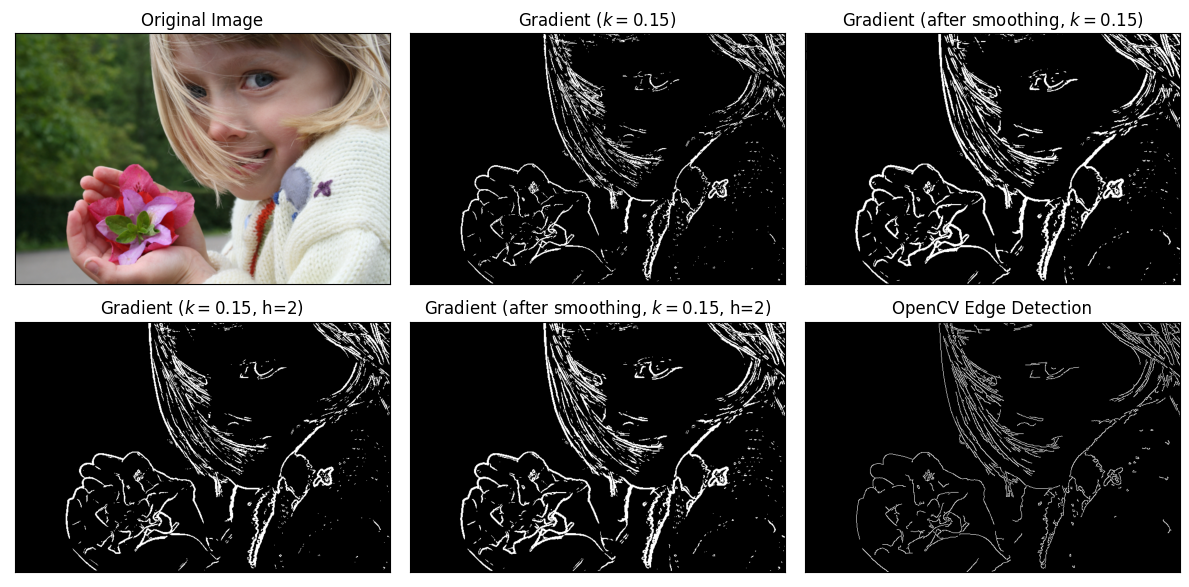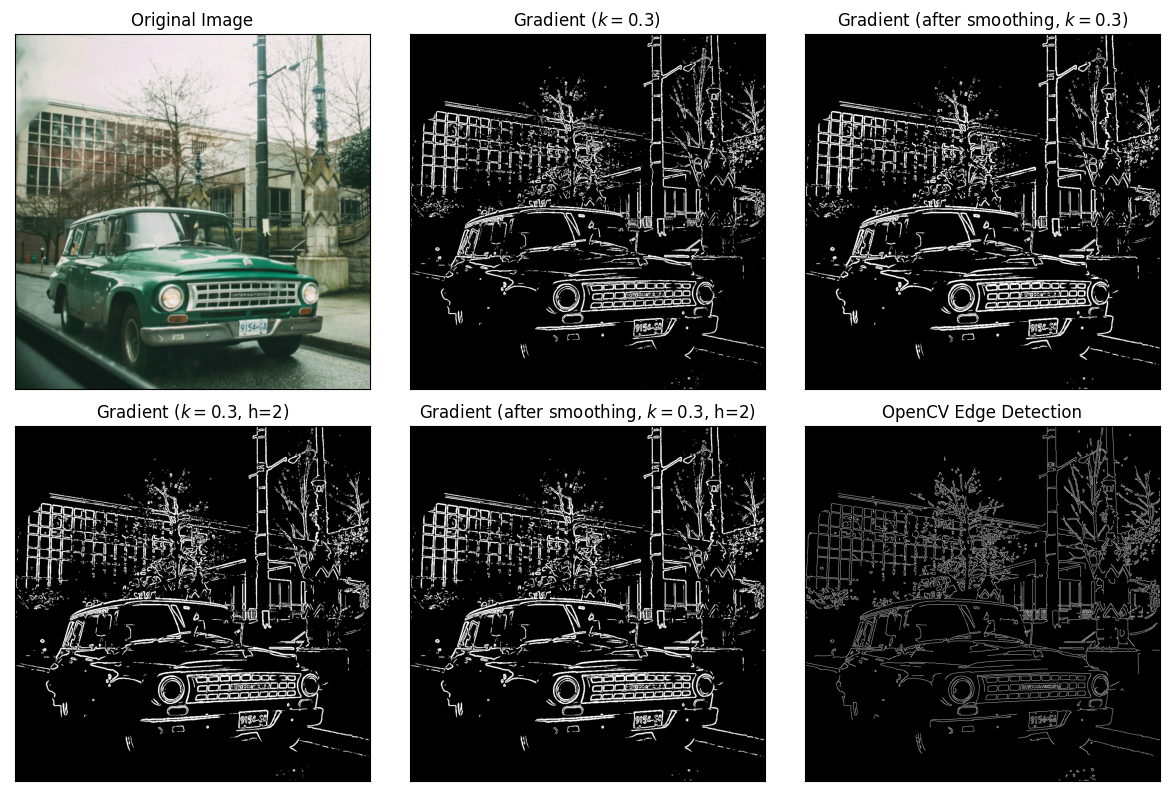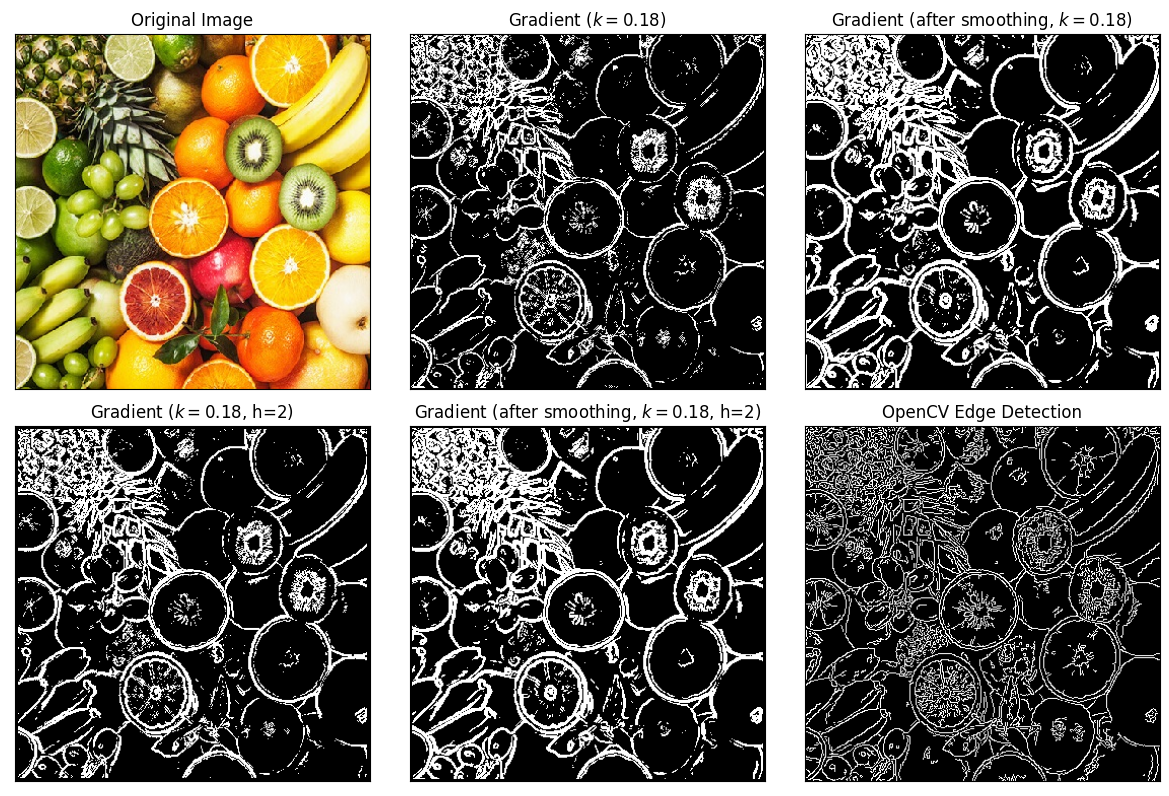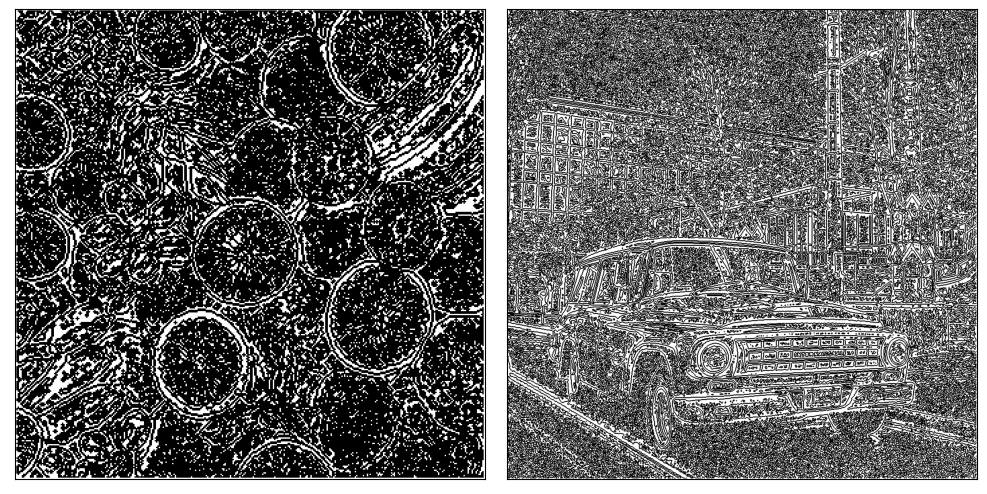Edge Detection in Images#
import matplotlib.image as mpimg
import numpy as np
import matplotlib.pyplot as plt
import cv2 as cv
Edges in images are discontinuities in intensity. They usually represent the boundaries of objects or lighting present in the image. It is one of the first steps in object detection models. Here, we will attempt to build an algorithm that can detect edges using the principles of numerical differentiation.
RGB to Grayscale Conversion#
Using the formula
def rgb2gray(rgb):
return np.dot(rgb[...,:3], [0.3, 0.59, 0.11])
Image Smoothing#
Linear smoothing which averages the pixel count with all 9 of its neighbours.
def blur(img, file=False):
if file:
img = mpimg.imread(img)
img = rgb2gray(img)
n = img.shape
smooth = img.copy()
# we ignore the edges as they are just 1 pixel
for x in range(1, n[0]-1):
for y in range(n[1]-1):
smooth[x,y] = (img[x,y]+img[x-1,y]+img[x+1,y]+\
img[x,y-1]+img[x-1,y-1]+img[x+1,y-1]+\
img[x,y+1]+img[x-1,y+1]+img[x+1,y+1])/9
return smooth
Masking Function#
def mask(img, k=0.25):
mk = np.where(img > k*np.max(img), 1, 0)
return mk
# fig = plt.figure()
# im = plt.imshow(mk, cmap='gray')
# fig.colorbar(im)
First Derivative approach#
The gradient of a 2D scalar matrix will give us the overall change in intensity around every point. If \(G\) represents our scalar matrix, the gradient at any point \((i,j)\) can be written as,
We can also extend this to the second order approximation (which includes 2 neighbouring pixels).
def nablaG(G,x,y,h=1):
if h == 1:
delx = (G[x+1,y]-G[x-1,y])/2
dely = (G[x,y+1]-G[x,y-1])/2
elif h == 2:
delx = (8*G[x+1,y]-G[x+2,y]-8*G[x-1,y]+G[x-2,y])/12
dely = (8*G[x,y+1]-G[x,y+2]-8*G[x,y-1]+G[x,y-2])/12
else:
return (0, 0)
return (delx, dely)
def gradient(img, h=1, file=False):
if file:
img = mpimg.imread(img)
img = rgb2gray(img)
n = img.shape
grad = np.zeros((img.shape[0], img.shape[1]), dtype=float)
for x in range(h, img.shape[0]-h):
for y in range(h, img.shape[1]-h):
g = nablaG(img, x, y, h=h)
grad[x, y] = np.sqrt(g[0]**2+g[1]**2)
return grad
Examples#
def show_edges(file, k=0.25, size=(12, 8)):
img_rgb = mpimg.imread(f'data/{file}')
img = rgb2gray(img_rgb)
plt.figure(figsize=size)
plt.subplot(231),plt.imshow(img_rgb)
plt.title('Original Image'), plt.xticks([]), plt.yticks([])
grad1 = gradient(img)
plt.subplot(232),plt.imshow(mask(grad1, k=k), cmap = 'gray')
plt.title('Gradient $(k=$'+f'{k})'), plt.xticks([]), plt.yticks([])
grad2 = gradient(blur(img))
plt.subplot(233),plt.imshow(mask(grad2, k=k),cmap = 'gray')
plt.title('Gradient (after smoothing, $k=$'+f'{k})'), plt.xticks([]), plt.yticks([])
grad3 = gradient(img, h=3)
plt.subplot(234),plt.imshow(mask(grad3, k=k), cmap = 'gray')
plt.title('Gradient $(k=$'+f'{k}, h=2)'), plt.xticks([]), plt.yticks([])
grad4 = gradient(blur(img), h=2)
plt.subplot(235),plt.imshow(mask(grad4, k=k),cmap = 'gray')
plt.title('Gradient (after smoothing, $k=$'+f'{k}, h=2)'), plt.xticks([]), plt.yticks([])
edges = cv.Canny(cv.imread(f'data/{file}', cv.IMREAD_GRAYSCALE), 100, 200)
plt.subplot(236),plt.imshow(edges, cmap = 'gray')
plt.title('OpenCV Edge Detection'), plt.xticks([]), plt.yticks([])
plt.tight_layout()
plt.savefig(f'plots/1/{file}', dpi=200)
plt.show()
show_edges('kid.png', k=0.15, size=(12,6))

show_edges('cara.png', k=0.3, size=(12,8))

show_edges('fruits.jpg', k=0.18, size=(12,8))

Second Derivative approach#
As we have seen in the previous section, the local maxima/minima in gradient values represent edge points. This means that at edge points, there will be a peak in the first derivative, and equivalently, there will be a zero crossing in the second derivative. Thus, edge points may be detected by finding the zero crossings of the second derivative of the image intensity.
The simplest way to find the second derivate of a scalar matrix is to find its Laplacian. Using the Taylor series expansion mentioned earlier, we can calculate the second derivate of a function as
Thus, the two-dimensional Laplacian will be,
def laplacian(img, h=1, file=True):
if file:
img = mpimg.imread(img)
img = rgb2gray(img)
lap = np.zeros((img.shape[0], img.shape[1]), dtype=float)
for x in range(h, img.shape[0]-h):
for y in range(h, img.shape[1]-h):
try:
np.seterr(over='ignore')
lap[x, y] = (img[x,y+1]+img[x,y-1]+img[x+1,y]+img[x-1,y]-4*img[x,y])/h**2
except RuntimeWarning as e:
# If a RuntimeWarning occurs, print the warning message
print(f"RuntimeWarning: {e}")
print(img[x,y+1],img[x,y-1],img[x+1,y],img[x-1,y],4*img[x,y])
return lap
def zero_crossings(img):
mk = np.ones((img.shape[0],img.shape[1]))
for x in range(1, img.shape[0]-1):
for y in range(1, img.shape[1]-1):
pix = img[x,y]
if pix*img[x-1,y] < 0 or pix*img[x+1,y] < 0 or pix*img[x,y+1] < 0 or pix*img[x,y-1] < 0:
mk[x,y] = 0
return mk
Examples#
plt.figure(figsize=(10,5))
plt.subplot(121)
lap = laplacian(blur('data/fruits.jpg', file=True), file=False)
im = plt.imshow(zero_crossings(lap), cmap='gray')
plt.xticks([]), plt.yticks([])
plt.subplot(122)
lap = laplacian(blur('data/cara.png', file=True), file=False)
im = plt.imshow(zero_crossings(lap), cmap='gray')
plt.xticks([]), plt.yticks([])
plt.tight_layout()
plt.savefig('plots/1/edge2.jpg', dpi=200)

